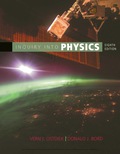
To rank the final temperature of water after adding different containers.
Answer to Problem 44Q
The final temperature of water according to different added container is ranked from largest to smallest temperature.
Explanation of Solution
Container A:
Given info:
The mass of water is
The temperature of water is
The mass of the container A is
The specific heat value for copper is
The specific heat value for water is
Formula used:
Formula to find the Final equilibrium temperature:
As amount of heat lost by copper is equal to the amount of heat gained by water,
Here,
Calculation:
Substitute the given values to find the final equilibrium temperature,
After simplifying we get,
Container B:
Given info:
The mass of water is
The temperature of water is
The mass of the container B is
The specific heat value for copper is
The specific heat value for water is
Formula used:
Formula to find the Final equilibrium temperature:
As amount of heat lost by copper is equal to the amount of heat gained by water,
Here,
Calculation:
Substitute the given values to find the final equilibrium temperature,
After simplifying we get,
Container C:
Given info:
The mass of water is
The temperature of water is
The mass of the container C is
The specific heat value for copper is
The specific heat value for water is
Formula used:
Formula to find the Final equilibrium temperature:
As amount of heat lost by copper is equal to the amount of heat gained by water,
Here,
Calculation:
Substitute the given values to find the final equilibrium temperature,
After simplifying we get,
Container D:
Given info:
The mass of water is
The temperature of water is
The mass of the container D is
The specific heat value for copper is
The specific heat value for water is
Formula used:
Formula to find the Final equilibrium temperature:
As amount of heat lost by copper is equal to the amount of heat gained by water,
Here,
Calculation:
Substitute the given values to find the final equilibrium temperature,
After simplifying we get,
Container E:
Given info:
The mass of water is
The temperature of water is
The mass of the container E is
The specific heat value for copper is
The specific heat value for water is
Formula used:
Formula to find the Final equilibrium temperature:
As amount of heat lost by copper is equal to the amount of heat gained by water,
Here,
Calculation:
Substitute the given values to find the final equilibrium temperature,
After simplifying we get,
Container F:
Given info:
The mass of water is
The temperature of water is
The mass of the container F is
The specific heat value for copper is
The specific heat value for water is
Formula used:
Formula to find the Final equilibrium temperature:
As amount of heat lost by copper is equal to the amount of heat gained by water,
Here,
Calculation:
Substitute the given values to find the final equilibrium temperature,
After simplifying we get,
After calculation the final temperature of water according to different added container is ranked from largest to smallest temperature as,
Conclusion:
Thus, the final temperature of water is ranked from largest to smallest temperature as,
Want to see more full solutions like this?
Chapter 5 Solutions
Inquiry into Physics
- 14. A boy is out walking his dog. From his house, he walks 30 m North, then 23 m East, then 120 cm South, then 95 m West, and finally 10 m East. Draw a diagram showing the path that the boy walked, his total displacement, and then determine the magnitude and direction of his total displacement.arrow_forwardPls help ASAParrow_forwardPls help ASAParrow_forward
- Pls help ASAParrow_forwardPls help ASAParrow_forward12. A motorboat traveling 6 m/s, West encounters a water current travelling 3.5 m/s, South. a) Draw a vector diagram showing the resultant velocity, then determine the resultant velocity of the motorboat. b) If the width of the river is 112 m wide, then how much time does it take for the boat to travel shore to shore? c) What distance downstream does the boat reach the opposite shore?arrow_forward
- Lake Erie contains roughly 4.00⋅10114.00⋅1011 m3 of water. Assume the density of this water is 1000. kg/m3 and the specific heat of water is 4186 J/kg˚C. It takes 2.31x10^19 J of energy to raise the temperature of that volume of water from 12.0 °C to 25.8 ˚C. An electric power plant can produce about 1110 MW. How many years would it take to supply this amount of energy by using the 1110 MW from an electric power plant?arrow_forwardPls help ASAParrow_forwardPls help ASAParrow_forward
- m m $2° 15. A truck is stopped at a red light. Once the light turns green, the truck accelerates forward at 1.75- that same instant, a car moving with a constant speed of 50 — passes the truck. a) How many seconds will it take for the truck to catch up to the car? S b) How many metres will the truck travel before it catches up to the car? Atarrow_forwardPls help ASAParrow_forwardI need help adding more information to my study guide. This is subject is physics My topic : Emission Spectrum Target Material I need information on this topic but make it as study guide form and make 5 questions and include the answers.arrow_forward


 An Introduction to Physical SciencePhysicsISBN:9781305079137Author:James Shipman, Jerry D. Wilson, Charles A. Higgins, Omar TorresPublisher:Cengage Learning
An Introduction to Physical SciencePhysicsISBN:9781305079137Author:James Shipman, Jerry D. Wilson, Charles A. Higgins, Omar TorresPublisher:Cengage Learning Principles of Physics: A Calculus-Based TextPhysicsISBN:9781133104261Author:Raymond A. Serway, John W. JewettPublisher:Cengage Learning
Principles of Physics: A Calculus-Based TextPhysicsISBN:9781133104261Author:Raymond A. Serway, John W. JewettPublisher:Cengage Learning College PhysicsPhysicsISBN:9781285737027Author:Raymond A. Serway, Chris VuillePublisher:Cengage Learning
College PhysicsPhysicsISBN:9781285737027Author:Raymond A. Serway, Chris VuillePublisher:Cengage Learning University Physics Volume 1PhysicsISBN:9781938168277Author:William Moebs, Samuel J. Ling, Jeff SannyPublisher:OpenStax - Rice University
University Physics Volume 1PhysicsISBN:9781938168277Author:William Moebs, Samuel J. Ling, Jeff SannyPublisher:OpenStax - Rice University





